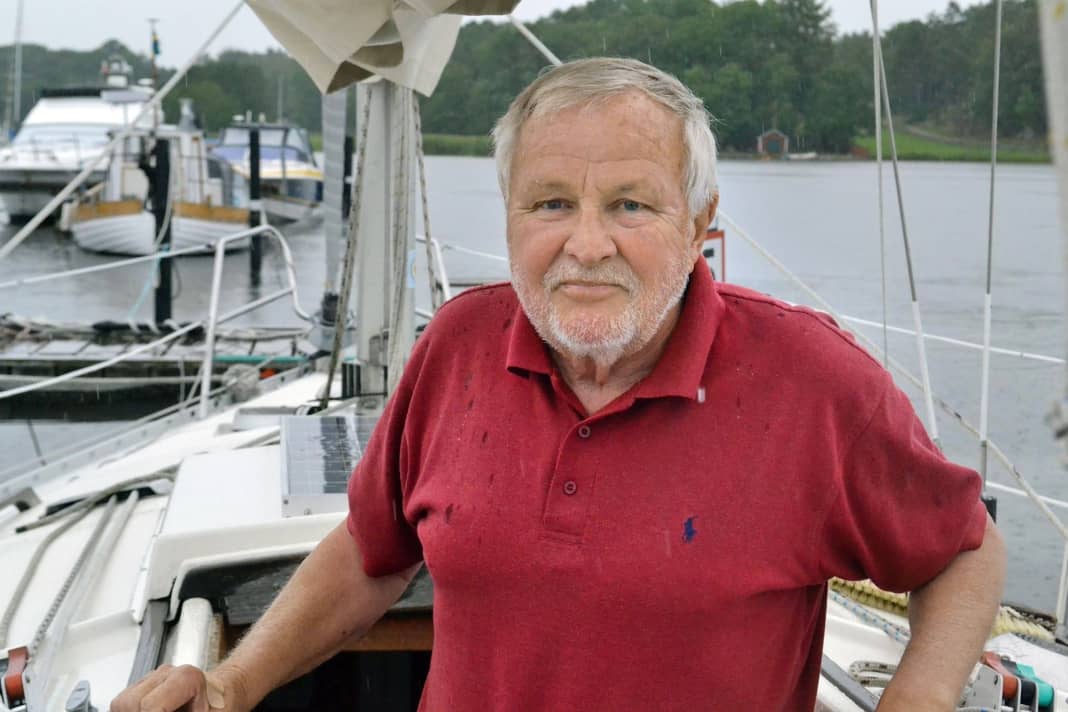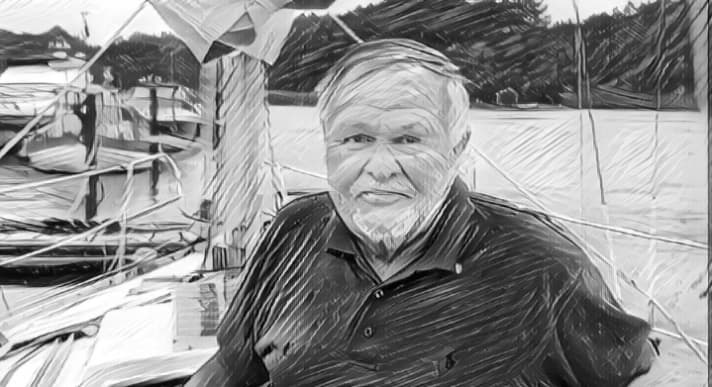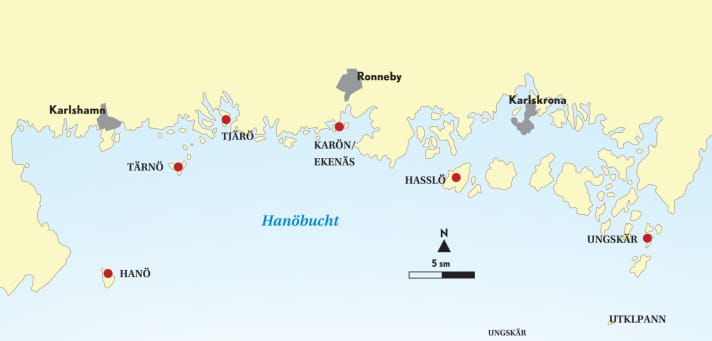Portrait: Unknown territory - Swede writes handbook about Blekinge archipelago
Ursula Meer
· 20.05.2023






In this article:
Sailors' dreams of Sweden often begin in the Stockholm archipelago. There, high up in the north, where it is wonderful to cruise through the narrow fairways during the day, where the sun only just dips below the horizon near midsummer and colours the still water between rocks, lichen and forests in pastel shades for whole nights.
On the way there, a quick stroke across Hanö Bay - and you've already missed a small, beautiful island world: the Blekinge archipelago. A jewel that stretches a good 30 nautical miles from west to east and boasts more than 800 islands and skerries. The nautical chart shows a frayed coastline, countless rocks, buoys and chum. But it also promises sheltered natural harbours and anchor bays.
If you don't shy away from precise navigation and go inside, you may come across an older gentleman who kindly takes the lines when you moor. With his medium build and blue eyes under white-blonde hair, he is perhaps indistinguishable from many of his compatriots. But if, after a brief chat, he offers you two notebooks full of information about the area, you've probably got it made. Thomas Karlsson to do. The 77-year-old knows the area like the back of his hand. He has been travelling through it for 60 years, from Hanö in the west to Utklippan in the east and further up north to Kalmar.
A guide to the archipelago from Sölvesborg via Gö to Kalmar
"I've always enjoyed writing and realised there was a certain need for information about my area," he explains. On long winter evenings, he therefore summarised what he knew about it and literally experienced there. The result is a two-volume compendium that covers the archipelago from Sölvesborg to Gö and Kalmar, 84 natural and urban harbours that awaken a spirit of discovery.
Graphically, a colourful mixture of watercolours by Swedish artist Lennart Paulsson, sketches, nautical chart excerpts, funny cartoons and photos. A treasure trove of content. Karlsson's practical tips go far beyond the usual information on moorings, approach and provisioning. There is hardly an underwater obstacle that is not mentioned. The reader also learns which anchorages have no evening sun or where there is excessively loud partying "and beer and home-brewed spirits and wine provide for lively fraternisation across generational boundaries".
Written like a cruise report, they are already a promise of Swedish summer on the sofa at home: "Enjoy a sunset with a view of the colourful toy houses of Ungskär and the unobstructed open sea to the east. The heart opens up and the soul purrs." The author adds a few anecdotes and tells us about the history of Blekinge and its people.
Karlsson's lines reveal a humorous man with subtle irony and the occasional wink. Everything that seems important or interesting to him is mentioned, such as where grog gets its name from or why Schärengarten is a mistranslation of Skärgård - but only in the German-language edition.
The idea of the German translation
This came about after a chance encounter: in 2003, Thomas Karlsson picks up the lines of a Laurin Koster from Germany at the guest jetty in Vägga harbour just outside Karlshamn. Bendix Klingeberg from Itzehoe is on a summer cruise in the Blekinge archipelago with his wife and already owns one of the guidebooks. Klingeberg speaks Swedish, they get talking and the idea of a German translation is quickly born.
It comes at the right time. Until 2001, large parts of Blekinge were still a restricted military area and taboo for foreigners, but now they can come. Klingeberg sets to work, tweaking sentences and fiddling with dialectal quotations. Not only does he translate, he also explains to the readership in the German-language edition, first published in 2004, about the Skärgård. There is nothing wrong with the translation "Schäre". Gård, however, has little to do with a garden, it is rather a farmstead with everything that goes with it: land, livestock and people. A whole economic area. "On holiday, however, we would probably rather sail in a garden than in an economic region; we just want to get away from that," says Karlsson.
The Côte d'Azur of Scandinavia
Karlsson treats German-speaking visitors to the romantic word that describes so much better what awaits them. Because southern Sweden is spoilt by the climate, lemon trees grow here and roses bloom in December. In fact, the region is known as the Garden of Sweden and by the particularly well-meaning as the Côte d'Azur of Scandinavia. Many a coastal dweller spends his entire sailing life in the Blekinge archipelago - and still discovers something new, summer after summer.
However, this island world was never romantic, life here was poor, barren and arduous," says Thomas Karlsson, and that this also applies to his past. He was just ten years old when his father died in a hunting accident. But despite being "small, poor and fatherless", he is enterprising, selling seeds and morning newspapers outside the church and travelling from door to door to sell fresh grass for the chickens. As a teenager, Karlsson works in the harbour, where he can do good business with strictly rationed schnapps. At the age of 16, he had enough money to buy his first boat, a snipe.
With its 4.70 metres, the dinghy fits into the tiniest of corners and also sails over shallower areas. Karlsson's exploration of the waters begins. From 1970, he continued his exploration with an Ohlson 22.
He studied economics in Gothenburg in the 1960s. He sold his final thesis to the motorboat magazine "Båtnytt", in which he investigated the influence of boat shows on consumer buying behaviour.
Karlsson works as a consultant at a bank and in a mail order company and teaches young and older people business management. On the side, he writes books, sells 3,000 copies of a book on how to get rich and final tests for schools, through which more than 30,000 pupils struggle.
In 1982, the economist is now the father of three biological daughters and another, and he buys a Scanmar 33. His "Johanna" may seem a little oversized in some tiny natural harbours and, at 1.75 metres, has quite a draught. But he only damages his boat and - worse still - his self-confidence once, when he mistakes a cardinal buoy and sits on it. Apart from that, the connoisseur of the area will always find a place to moor with careful manoeuvres.
From Åland to Holland
Karlsson enjoys taking short trips in his micro-territory just as much as he enjoys travelling extensively to Åland, Denmark and Norway, to the German Baltic coast and across the North Sea to Holland, in the past with his wife and children. Today, Thomas describes himself as "happily divorced", still good friends with his ex-wife and very proud of his four daughters, who have all gone on to have respectable careers. On his milestone birthdays, he invites the whole family on trips to Mexico, Tanzania or on the Hurtigruten.
These trips are not financed by the sale of the books. He doesn't get rich from it, but he hasn't made any losses either. How many guides he has sold to date is his trade secret. In any case, the sympathy he receives and the positive feedback are the greatest reward for his ego.
And so Karlsson gives lectures about Blekinge, speaks on the radio and writes articles. But he doesn't want to become too famous; it's hard to coax a photo of himself out of him. This can sometimes lead to situations that are difficult to explain, such as when a female sailor he doesn't know calls his name with exuberant delight - and his daughters look at their father with wide eyes.
But there are also those moments when sailors thank him for his tireless research and area updates. Then someone might bring him home-grown tomatoes, honey from his own apiary or come alongside with two beers.
I receive gifts from the German sailors in particular," Karlsson says with a smile.
Probably because they find beautiful bays and places thanks to his tireless research.
Trusting the word of honour among sailors
For several years, the German edition was even sold with some success by a major German publisher. Since the publisher stopped selling them, the author has relied on the word of honour among sailors: he sends them out in PDF format on request. It would be easy to distribute them free of charge, but "I hope for honesty". He also does without advance payment, as the payment behaviour of his customers is consistently good. As a precaution, he has nevertheless added a warning to his books: "Copying this booklet will lead to scurvy, reputation-damaging illnesses after a visit to the harbour, mast breakages, engine malfunctions, doldrums, sudden sea fog and dramatic encounters with unknown shallows. Do not expose your ship and crew to these dangers!"
"Incidentally," Karlsson continues, "if anyone is interested in acquiring the rights for the German-language edition, I'm open to discussing it."
The 77-year-old is not thinking of giving up. In spring, he personally brings his little books to the small bookshops along his coast, and in autumn he picks up any leftover copies. He lives on his "Johanna" from May to the end of August. Close to the action in Blekinge, he can always publish the latest information about the area on his blog. He also sells his books online from here. He doesn't have an online shop for this and certainly doesn't dock onto large mail order companies. A simple e-mail is all it takes for the delivery to go out within a day at the latest. That is his voluntary commitment.
Only sometimes, when his "Johanna" is gently swinging around the anchor in a quiet bay on a sunny Sunday morning, does the pensioner hope: "Please no customers today! I just want to stay here," and adds with a laugh: "What a great trader!"
About the person: Thomas Karlsson

The 77-year-old Swede from Karlshamn has been a sailor since his youth and knows his home waters like no other. In two publications, which are also available in German, he shares his knowledge and does not limit himself to nautical information
- You can find the latest information from Thomas Karlsson on blekingeskargard.com
Thomas Karlsson's sailing recommendations for the Blekinge archipelago
Countless anchor bays, natural harbours and four small towns with welcoming harbours can be found in the Blekinge archipelago - it's hard to choose. Area expert Thomas Karlsson recommends six places, from the east with its charming, barren outer archipelago to the lovelier western part.

1. unkär
The harbour of the small archipelago can be reached via a narrow, rough fairway. Above its sturdy piers is a small collection of pretty little houses with colourful gardens and countless hedgehogs. On the seaward side, the small archipelago features impressive rock formations interspersed with glittering quartz. Boats with a draught of more than 1.80 metres can alternatively call at Stenshamn.

2nd Hasslö
The island is quite flat and is ideal for cycling tours through a vast heath landscape or a swimming trip to the fine sandy beach at Sandviken in the south. It was once the centre of fishing in the eastern archipelago. The large fishing harbour Garpahamnen in the east has guest berths and a shipyard.

3. Karön/Ekenäs near Ronneby
The enchanting island of Karön boasts beautiful scenery and magnificent old wooden villas with carved facades, bay windows and verandas. Opposite is Ekenäs, Ronneby's marina, where there is electricity, water, fuel and a restaurant.

4. tjärö
The holiday and water sports island looks like a Swedish paradise. Yet hardly anything here is artificially staged. All the ingredients are here: sauna, croft, hiking trails, old forests and beautiful moorings, either at anchor or on rocky hooks and jetties.

5.Tärnö
On the small headland of Tjuvanabben in the north, one of the oldest oak trees in Blekinge has been standing for more than 300 years. You can admire impressive cliff formations on hikes through the forest and meadows. Sweden's oldest wooden lighthouse, built in 1910 and still in use today, stands on the highest point, Drakaberg. Treasure hunters go for a walk on the southern shore of the island, where the flotsam of the entire southern Baltic Sea comes ashore.

6th Hanö
A more than rich flora and fauna and breathtaking views from the 60 metre high Fyrkullen characterise the island in the far west of the archipelago. It is quite easy to get to and a very popular stopover in Hanö Bay. In summer, the harbour can get very crowded, so expect small packets.


